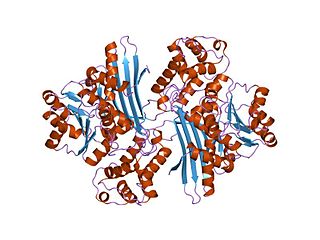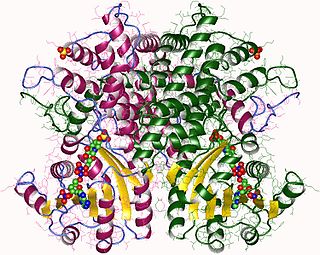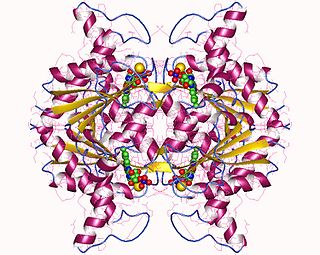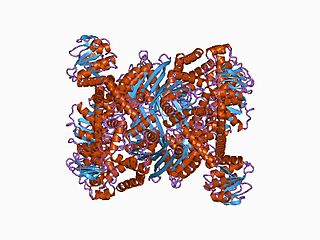
Acetoin, also known as 3-hydroxybutanone or acetyl methyl carbinol, is an organic compound with the formula CH3CH(OH)C(O)CH3. It is a colorless liquid with a pleasant, buttery odor. It is chiral. The form produced by bacteria is (R)-acetoin.

2,3-Butanediol fermentation is anaerobic fermentation of glucose with 2,3-butanediol as one of the end products. The overall stoichiometry of the reaction is

In molecular biology, the protein domain Saccharopine dehydrogenase (SDH), also named Saccharopine reductase, is an enzyme involved in the metabolism of the amino acid lysine, via an intermediate substance called saccharopine. The Saccharopine dehydrogenase enzyme can be classified under EC 1.5.1.7, EC 1.5.1.8, EC 1.5.1.9, and EC 1.5.1.10. It has an important function in lysine metabolism and catalyses a reaction in the alpha-Aminoadipic acid pathway. This pathway is unique to fungal organisms therefore, this molecule could be useful in the search for new antibiotics. This protein family also includes saccharopine dehydrogenase and homospermidine synthase. It is found in prokaryotes, eukaryotes and archaea.
In enzymology, a sorbitol-6-phosphate dehydrogenase (EC 1.1.1.140) is an enzyme that catalyzes the chemical reaction

In enzymology, a D-xylulose reductase (EC 1.1.1.9) is an enzyme that catalyzes the chemical reaction

In enzymology, a (R,R)-butanediol dehydrogenase (EC 1.1.1.4) is an enzyme that catalyzes the chemical reaction

Glycerol dehydrogenase (EC 1.1.1.6, also known as NAD+-linked glycerol dehydrogenase, glycerol: NAD+ 2-oxidoreductase, GDH, GlDH, GlyDH) is an enzyme in the oxidoreductase family that utilizes the NAD+ to catalyze the oxidation of glycerol to form glycerone (dihydroxyacetone).

In enzymology, a glycerate dehydrogenase (EC 1.1.1.29) is an enzyme that catalyzes the chemical reaction

In enzymology, a phosphogluconate dehydrogenase (decarboxylating) (EC 1.1.1.44) is an enzyme that catalyzes the chemical reaction
In enzymology, a 1,3-propanediol dehydrogenase (EC 1.1.1.202) is an enzyme that catalyzes the chemical reaction
In enzymology, a (S,S)-butanediol dehydrogenase (EC 1.1.1.76) is an enzyme that catalyzes the chemical reaction
In enzymology, a mycothiol-dependent formaldehyde dehydrogenase (EC 1.1.1.306) is an enzyme that catalyzes the chemical reaction

In enzymology, a NAD(P)H dehydrogenase (quinone) (EC 1.6.5.2) is an enzyme that catalyzes the chemical reaction
Nitroreductases are a family of evolutionarily related proteins involved in the reduction of nitrogen-containing compounds, including those containing the nitro functional group. Members of this family utilise flavin mononucleotide as a cofactor and are often found to be homodimers.

In molecular biology, the ELFV dehydrogenase family of enzymes include glutamate, leucine, phenylalanine and valine dehydrogenases. These enzymes are structurally and functionally related. They contain a Gly-rich region containing a conserved Lys residue, which has been implicated in the catalytic activity, in each case a reversible oxidative deamination reaction.
Acetoin dehydrogenase (EC 2.3.1.190, acetoin dehydrogenase complex, acetoin dehydrogenase enzyme system, AoDH ES) is an enzyme with systematic name acetyl-CoA:acetoin O-acetyltransferase. This enzyme catalyses the following chemical reaction
Diacetyl reductase ((R)-acetoin forming) (EC 1.1.1.303, (R)-acetoin dehydrogenase) is an enzyme with systematic name (R)-acetoin:NAD+ oxidoreductase. This enzyme catalyses the following chemical reaction
D-xylose reductase (EC 1.1.1.307, XylR, XyrA, msXR, dsXR, monospecific xylose reductase, dual specific xylose reductase, NAD(P)H-dependent xylose reductase, xylose reductase) is an enzyme with systematic name xylitol:NAD(P)+ oxidoreductase. This enzyme catalyses the following chemical reaction

NADH:ubiquinone reductase (non-electrogenic) (EC 1.6.5.9, NDH-2, ubiquinone reductase, coenzyme Q reductase, dihydronicotinamide adenine dinucleotide-coenzyme Q reductase, DPNH-coenzyme Q reductase, DPNH-ubiquinone reductase, NADH-coenzyme Q oxidoreductase, NADH-coenzyme Q reductase, NADH-CoQ oxidoreductase, NADH-CoQ reductase) is an enzyme with systematic name NADH:ubiquinone oxidoreductase. This enzyme catalyses the following chemical reaction:
Acireductone synthase (EC number 3.1.3.77, E1, E-1 enolase-phosphatase) is an enzyme with systematic name 5-(methylsulfanyl)-2,3-dioxopentyl-phosphate phosphohydrolase (isomerizing). It catalyses the following reaction:












